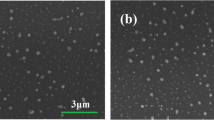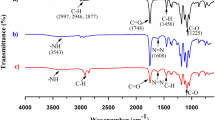Abstract
Antimicrobial polyamide 11 (PA-11) films containing low-cost, thermally stable and water resistant polymeric biocide polyhexamethylene guanidine dodecylbenzenesulfonate (PHMG-DBS) have been obtained by compression moulding. The structure of the modified PA-11 films containing from 3 to 10 wt% of PHMG-DBS was characterized using Raman and FTIR spectroscopy and atomic force microscopy (AFM). The surface properties were evaluated both by contact angle and contactless inductive method. The introduction of PHMG-DBS into PA-11 films was found to increase positive surface charge density to 5.5·10−11 C/cm2 for 10 wt% of PHMG-DBS. Antibacterial activity of PA-11/PHMG-DBS films against both Gram-positive (Escherichia coli) and Gram-negative (Bacillus subtilis) bacteria was demonstrated for films containing from 5 to 7 wt% of polymeric biocide. According to thermal investigations data, PA-11/PHMG-DBS composite has excellent thermal stability to at least 390 °C both in air and in argon atmosphere which indicates on its availability for the melt processing by common methods. It has also been found that polymeric biocide is highly resistant to leaching from PA-11 film.










Similar content being viewed by others
References
Kohan MI (1995) Nylon Plastics Handbook. Hanser Gardner Publications, New York
Arkema (2005) RILSAN® PA11: created from a renewable source (product data sheet). Arkema, Puteaux
Mason J (1998) Pipe liners for corrosive high-temperature oil and gas-production applications. Mater Perform 37:34–40
Dawans FA, Jarrin J, Lefevre TO, Pelisson M (1986) Improved thermoplastic materials for offshore flexible pipes. In: Proceedings of Offshore Technology Conference, OTC No. 5231-MS, Houston
Arkema (2010) Fine powders: a durable coating for durable products (product data sheet). Arkema, Colombes
Klun U, Friedrich Z, Kržan A (2003) Polyamide 6 fibre degradation by a lignolytic fungus. Polym Degrad Stab 79:99–104
Tomita K, Ikeda N, Ueno A (2003) Isolation and characterization of a thermophilic bacterium, Geobacillus thermocatenulatus, degrading nylon 12 and nylon 66. Biotechnol Lett 25:1743–1746
Mohee R, Unmar G (2007) Determining biodegradability of plastic materials under controlled and natural composting environments. Waste Manag 27:1486–1493
Al-Gelawi MH, Al-Saraf AA, Al-Baldawi RB (2013) Role of plasmid of Pseudomonas putida S3A in Nylon 6 degradation. J Biol Sci 13:555–558
Chonde Sonal G, Chonde Sachin G, Raut PD (2013) Studies on degradation of synthetic polymer Nylon 6 and Nylon 6, 6 by Pseudomonas aeruginosa NCIM 2242. IJETCAS 4:362–369
Kaali P, Strömberg E, Karlsson S (2011) Prevention of biofilm associated infections and degradation of polymeric materials used in biomedical applications. In: Laskovski AN (ed) Biomedical engineering, trends in material science, vol Chapter 22. In Tech, Rijeka, pp 513–541
Ramachandran T, Rajendrakumar K, Rajendran R (2004) Antimicrobial textiles—an overview. Textile Eng 84:42–47
Nichols D (2005) Biocides in plastics. Rapra review reports, Rapra Technology, 15: Report 180
Kuratsuji T, Shimizu H (2003) Polyamide based antibacterial powder paint composition. US Patent 20030171452
Lapeyre A, Ganset C (2005) Polyamide-based powder and its use for obtaining an antibacterial coating. US Patent 8303970
Russel AD, Hugo WB (1994) Antimicrobial activity and action of silver. Prog Med Chem 31:351–370
Feng QL, Wu J, Chen GQ, Cui FZ, Kim TN, Kim JO (2000) A mechanistic study of the antibacterial effect of silver ions on Escherichia coli and Staphylococcus aureus. J Biomed Mater Res 52:662–668
Kumar R, Münstedt H (2005) Silver ion release from antimicrobial polyamide/silver composites. Biomater 26:2081–2088
Damm C, Münstedt H, Rösch A (2007) Long-term antimicrobial polyamide 6/silver-nanocomposites. J Mater Sci 42:6067–6073
Damm C, Münstedt H, Rösch A (2008) The antimicrobial efficacy of polyamide 6/silver-nano- and microcomposites. Mater Chem Phys 108:61–66
Williams RL, Doherty PJ, Vince DJ, Grashoff GJ, Williams DF (1989) The biocompatibility of silver. Crit Rev Biocompat 5:221–223
Carmona-Ribeiro AM, de Melo Carrasco LD (2013) Cationic antimicrobial polymers and their assemblies. Int J Mol Sci 14:9906–9946
Oulè MK, Azinwi R, Bernier AM, Kablan T, Maupertuis AM, Mauler S, Koffi- Nevry R, Dembèlè K, Forbes L, Diop L (2008) Polyhexamethylene guanidine hydrochloride-based disinfectant: a novel tool to fight meticillin-resistant Staphylococcus aureus and nosocomial infections. J Med Microbiol 57:1523–1528
Mathurin YK, Koffi-Nevry R, Guéhi ST, Tano K, Oulé MK (2012) Antimicrobial activities of polyhexamethylene guanidine hydrochloride-based disinfectant against fungi isolated from cocoa beans and reference strains of bacteria. J Food Protect 75:1167–1171
Qian L, Guan Y, He B, Xiao H (2008) Modified guanidine polymers: synthesis and antimicrobial mechanism revealed by AFM. Polymer 49:2471–2475
Zhou Z, Wei D, Guan Y, Zheng A, Zhong J-J (2010) Damage of Escherichia coli membrane by bactericidal agent polyhexamethylene guanidine hydrochloride: micrographic evidences. J Appl Microbiol 108:898–907
Zhou Z, Wei D, Guan Y, Zheng A, Zhong J-J (2011) Extensive in vitro activity of guanidine hydrochloride polymer analogs against antibiotics-resistant clinically isolated strains. Mater Sci Eng 31:1836–1843
Kukharenko O, Bardeau J-F, Zaets I, Ovcharenko L, Tarasyuk O, Porhyn S, Mischenko I, Vovk A, Rogalsky S, Kozyrovska N (2014) Promising low cost antimicrobial composite material based on bacterial cellulose and polyhexamethylene guanidine hydrochloride. Eur Polym Jnl 60:247–254
Nigmatullin R, Gao F, Konovalova V (2009) Permanent, non-leaching antimicrobial polyamide nanocomposites based on organoclays modified with a cationic polymer. Macromol Mater Eng 294:795–805
Rogalskyy S, Bardeau J-F, Tarasyuk O, Fatyeyeva K (2012) Fabrication of new antifungal polyamide-12 material. Polym Int 61:686–691
Faille C, Jullien C, Fontaine F, Bellon-Fontaine M-N, Slomianny C, Benezech T (2002) Adhesion of Bacillus spores and Escherichia coli cells to inert surfaces: role of surface hydrophobicity. Can J Microbiol 48:728–738
Haghi AK, Zaikov GE (2013) Updates on polymer composites and fibers for advanced technologies. In: Zaikov GE, Lekishvili NG, Medvedevskikh YJ (eds) Multicomponent polymeric materials: from introduction to application. Apple Academic Press Inc, Point Pleasant, pp 169–173
Sedin VA, Yarovoi GP (1971) Measurement of surface charge and external field potential of an electret. Meas Tech 14:439–443
Fatyeyeva K, Pud AA, Bardeau J-F, Tabellout M (2011) Structure–property relationship in aliphatic polyamide/polyaniline surface layered composites. Mater Chem Phys 130:760–768
Marmur A (2006) Soft contact: measurement and interpretation of contact angles. Soft Matter 2:12–17
An YH, Friedman RJ (1998) Concise review of mechanisms of bacterial adhesion to biomaterial surfaces. J Biomed Mater Res 43:338–348
Kügler R, Bouloussa O, Rondelez F (2005) Evidence of a charge-density threshold for optimum efficiency of biocidal cationic surfaces. Microbiology 151:1341–1348
Lewis K, Klibanov AM (2005) Surpassing nature: rational design of sterile-surface materials. Trends Biotechnol 23:343–348
Siedenbiedel F, Tiller JC (2012) Antimicrobial polymers in solution and on surfaces: overview and functional principles. Polymers 4:46–71
Izmaylov B, Di Gioia D, Markova G, Aloisio I, Colonna M, Vasnev V (2015) Imidazolium salts grafted on cotton fibres for long-term antimicrobial activity. React Funct Polym 87:22–28
Guo N, Hu D, Wang H, Wang R, Xiong Y (2013) Functional poly(ethylene terephthalate) materials prepared by condensation copolymerization with ionic liquids. Polym Bull 70:3031–3040
Walczak M, Richert A, Burkowska-But A (2014) The effect of polyhexamethylene guanidine hydrochloride (PHMG) derivatives introduced into polylactide (PLA) on the activity of bacterial enzymes. J Ind Microbiol Biotechnol 41:1719–1724
Gilbert P, Moore LE (2005) Cationic antiseptics: diversity of action under a common epithet. J Appl Microbiol 99:703–715
Lee JC, Koo JH, Ezekoye OA, Erickson K (2009) Heating rate and nanoparticle loading effects on thermoplastic polyurethane elastomer nanocomposite kinetics. 41st AIAA Thermophysics Conference, San Antonio, Texas
Lyon RE, Walters RA (2002) A microscale combustion calorimeter, final report DOT/FAA/AR-01/117. NTIS, Springfield
Acknowledgements
The authors are grateful to Arkema (USA) for providing PA-11 samples.
Author information
Authors and Affiliations
Corresponding author
Electronic supplementary material
Below is the link to the electronic supplementary material.
Rights and permissions
About this article
Cite this article
Rogalsky, S., Bardeau, JF., Wu, H. et al. Structural, thermal and antibacterial properties of polyamide 11/polymeric biocide polyhexamethylene guanidine dodecylbenzenesulfonate composites. J Mater Sci 51, 7716–7730 (2016). https://doi.org/10.1007/s10853-016-0054-x
Received:
Accepted:
Published:
Issue Date:
DOI: https://doi.org/10.1007/s10853-016-0054-x




